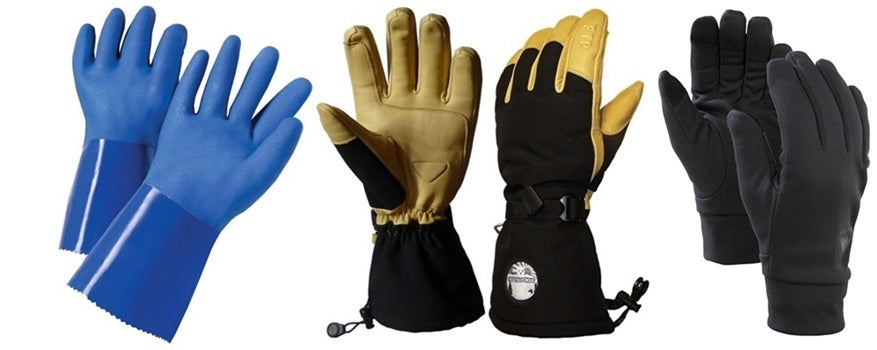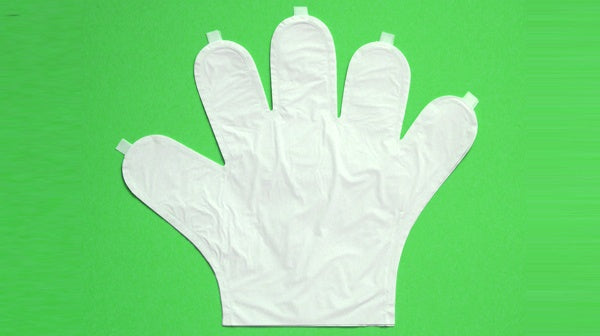Waterproof ski gloves: The best method
What is the best waterproofing strategy for ski gloves?
That is a much more complicated question than most people think, if your goal is best possible performance and fit on most days and in most conditions.
You have to not only consider water from the exterior environment, but also water from interior environment of the glove.
Sweat.
On one end of the spectrum, and the only gloves that are truly waterproof, are gloves made of 100% non-breathable 100% water-proof rubber (ignoring the water that can enter from the entry opening). On the other end of the spectrum are very thin liner gloves made of polyester, which have nearly 99% breathability and almost zero water-resistance. Every other glove falls somewhere in between. The more "waterproof" they are, while still holding onto the maximum amount of breathability, the more expensive they are. And that has fueled an incredible arms race-like competition between the largest chemical companies, clothing manufacturers, and ski glove companies.

The fundamental flaw in the "water-proof breathable" concept is that none work as advertised, at least in regards to ski gloves. The combination of insulation thickness, liner material, exterior shell material, leather or synthetics, the outside environment, activity level and the wide range of differences between individual human sweat glands, make the solution to best possible performance and fit on most days and in most conditions really difficult to solve with modern technology.
Your hands are going to get warm and they are going to sweat. And that is going to happen a lot more than it's going to snow or rain.
The ski glove that offers the best protection from outside moisture, provides the worst protection from inside moisture.
The ultimate goal is dry hands.
Recognizing this reality, sets the priorities for Free the Powder Gloves. Make the the driest glove, balancing the competing moisture problems.
But before we jump straight to that solution, we also have to consider the performance of the glove in regards to USE. That means grip and dexterity. First off, placing a membrane insert liner "plastic glove" between the shell and liner of your ski gloves permanently and adversely effects the dexterity of your gloves. No way around that fact.

Secondly, most leather ski glove makers finish their tanning process with a silicone-based proofing treatment. In addition, most after-market waterproofing products use silicone-based material to create the water barrier. It does an excellent job of performing that task, but it clogs the pours of the leather, and worse, it creates the shiny, slippery texture on the outside surface of the leather. That's what you really need to look for.
Does the water-proofing treatment of the leather or after-market water-proofer make the leather slippery, smooth? If it does, there goes your grip.
Free the Powder does not use silicone-based waterproofing or anything else that degrades the grip of the leather. It's better to give up a little bit of water-proofing to get a lot better grip and dexterity.
So, to finally get to the point, what is the best waterproofing for ski gloves to maximize the amount of time with dry hands?
A ski glove that is as water-resistant as you can make it without decreasing it's breathability.
That means no insert membrane like Gore-Tex®. Forget the hype, all insert membranes are essentially plastic bag liners. They are not air permeable, which means that moisture has to build up on the inside in order to open the breathing pores. Insert membranes are primarily designed to keep the water out. Even the best of them are much less breathable than no-membrane at all.
Membrane insert gloves are very practical and good to own as a specialty glove for certain wet conditions, but they have much less versatility as an everyday glove.
As a glove designer, I have performed the kind of field testing that few others have. I spent an entire ski season (100+ days) wearing a membrane insert glove on one hand and a non-membrane glove on the other. The rest of the design characteristics were exactly the same. Most of the time the membrane insert caused clammy hands, whereas the non-membrane glove was almost always dry. On the days when it was raining, both gloves got saturated with water. Water always finds a way inside gloves because they have a basic, un-fixable design problem: a big hole where your hand goes in. For me and my team of testers, on most days the membrane insert gloves were less effective overall.
But someday, when we find a "waterproof-breathable" membrane insert that works to our satisfaction, we will offer them in our gloves.
Sorry, I got off on my membrane insert tangent. Back to the answer: How to make the driest glove?
1) No membrane insert.
2) Use all breathable materials.
3) Strong DWR (durable water repellent) on nylon fabric.
4) Leather that is tanned to be water-resistant, while retaining the soft, grippy texture.
5) Proper stitching of seams.
There you go. Maximize the amount of time your hands are dry!
Why Free the Powder?
-
Premium Quality
We use the best quality leather and the most breathable materials in order to make the warmest and toughest ski gloves and mittens.
-
Superior Value
Why pay a triple digit markup for quality? We sell our premium leather ski gloves direct at lower prices than our competitors.
-
Free Fast Shipping
No one wants to wait for their order to ship. You'll get your gloves and mittens fast! We get your order out to you ASAP.
